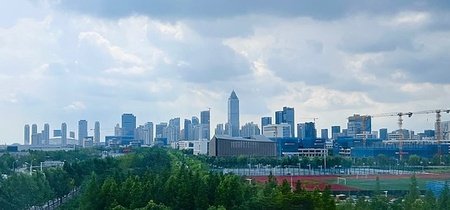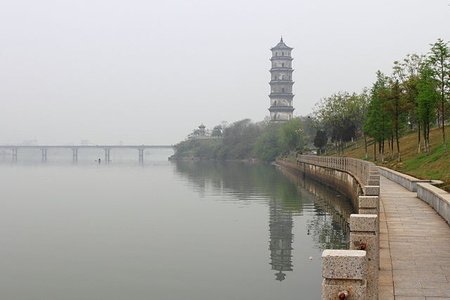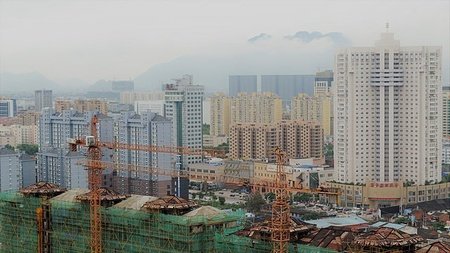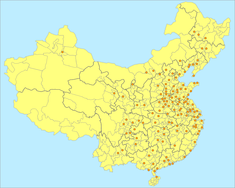
Every 1M+ Chinese City #6
Last updated: Wednesday April 19th, 2023
Report this blog
In the previous blog, I went through 17 cities in the Jianghuai region. Here I will move south along the coast and go through another 16.
Shanghai
Name
Simplified Chinese: 上海
Traditional Chinese: 上海
Pronunciation
Mandarin pinyin: shàng hăi
Cantonese jyutping: soeng6 hoi2
Population
citypopulation.de: 40,000,000
census 2020 (metro): 24,870,895
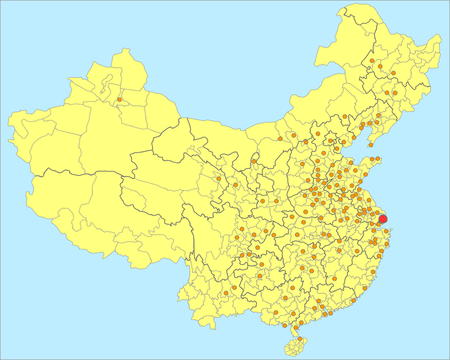
Shanghai, the largest and the richest city in China, does not need much further introduction. Similar to Hong Kong, Shanghai was transformed from a sleepy fishing village to a modern metropolis after the First Opium War. Since then, the French and International concessions were established on the west bank of the Huangpu River. In the 1990s, Pudong on the opposite side was developed into a new CBD. Today, Shanghai is a global financial centre, an alpha+ city, and the "New York of China".
Note that in the citypopulation.de list, the agglomeration includes adjacent (and not-so-adjacent) cities which are important and you should know these too:
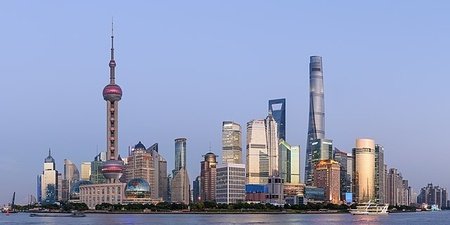
Suzhou (苏州 / 蘇州, pop. 6,715,559) lies 85 km west of Shanghai. It gives the short name Su to Jiangsu. Historically it was the largest city after Luoyang, and one of the three major commercial centres along with Yangzhou and Guangzhou. Its many canals, gardens, stone bridges and pagodas have always been popular with tourists, as described in phrases such as "Heaven above and Su-Hang below" (referring to Suzhou and Hangzhou), or "Venice of the East".
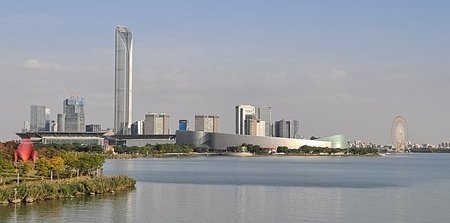
Wuxi (无锡 / 無錫, pop. 4,336,835) lies 40 km northwest of Suzhou and 120 km from Shanghai. The disputed origin of its name, which means "no tin", referred to the many military contests for its tin mines, hence the phrase "with no tin there will be peace". Wuxi is a prominent cultural and historical city; a production and trading hub for textile, silk and rice. Today, it remains an important commercial city and the second highest GDP per capita in mainland China (after Shenzhen).

Changzhou (常州, pop. 3,907,948) lies another 40 km northwest of Wuxi and 160 km from Shanghai (similar distance to New York-Hartford or London-Birmingham). A large city on the key route between Shanghai and Nanjing, it now has its own metro lines and an international airport.
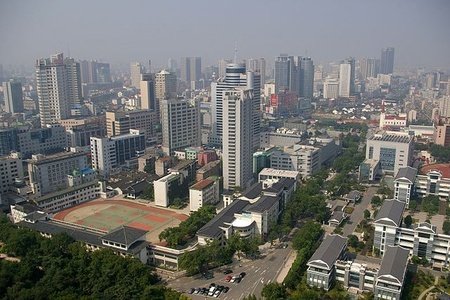
Nantong
Name
Simplified Chinese: 南通
Traditional Chinese: 南通
Pronunciation
Mandarin pinyin: nán tōng
Cantonese jyutping: naam4 tung1
Population
citypopulation.de: 3,250,000
census 2020 (metro): 3,766,534

Jiangyin
Name
Simplified Chinese: 江阴
Traditional Chinese: 江陰
Pronunciation
Mandarin pinyin: jiāng yīn
Cantonese jyutping: gong1 jam1
Population
citypopulation.de: 3,025,000
census 2020 (metro): 1,779,515
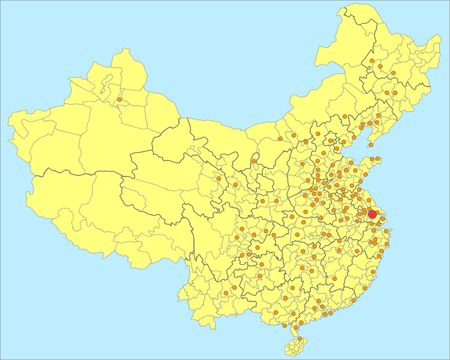
Jiangyin is a county-level city under Wuxi. The citypopulation list includes the nearby Zhangjiagang (张家港 / 張家港, pop. 1,432,044) which is another county-level city under Suzhou. Both are medium size cities on the southern bank of the Yangtze delta and will likely be counted as part of Shanghai in the future.
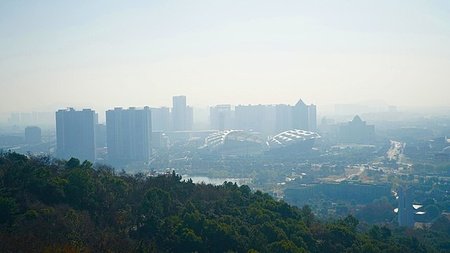
Huzhou
Name
Simplified Chinese: 湖州
Traditional Chinese: 湖州
Pronunciation
Mandarin pinyin: hú zhōu
Cantonese jyutping: wu4 zau1
Population
citypopulation.de: 1,630,000
census 2020 (metro): 1,558,826
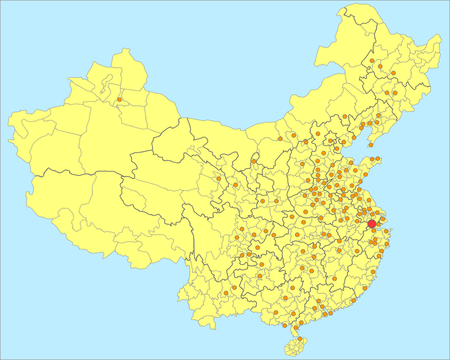
Huzhou on the southern shore of Taihu or Lake Tai, is known as the City of Silk. It is also known for its Huzhou ink brush, one of the Four Treasures of the Study in China.

Jiaxing
Name
Simplified Chinese: 嘉兴
Traditional Chinese: 嘉興
Pronunciation
Mandarin pinyin: jiā xīng
Cantonese jyutping: gaa1 hing1
Population
citypopulation.de: 2,075,000
census 2020 (metro): 1,518,654
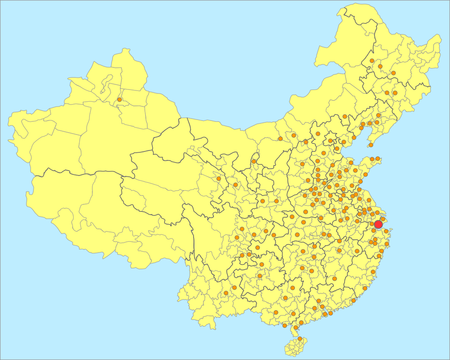
Jiaxing lies midway between Shanghai and Hangzhou. It was another typical town built on water and a food bowl south of Yangtze. The nearby Wuzhen is a popular tourist destination with well preserved canals and ancient township.
Again, it is less than 90 km southwest of Shanghai, and will probably be counted as part of it in the future citypopulation list.
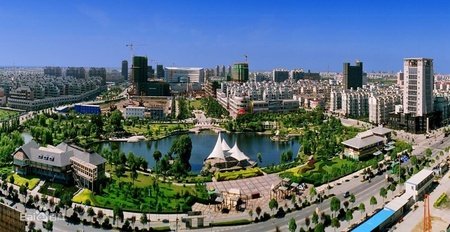
Hangzhou
Name
Simplified Chinese: 杭州
Traditional Chinese: 杭州
Pronunciation
Mandarin pinyin: háng zhōu
Cantonese jyutping: hong4 zau1
Population
citypopulation.de: 13,400,000
census 2020 (metro): 9,535,397
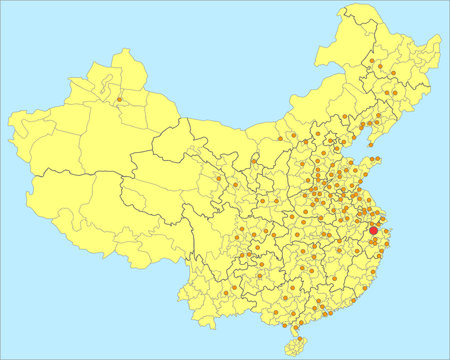
Hangzhou, as mentioned above, has long been considered the "heaven on earth" and the most beautiful city in China; and the West Lake is its best known tourist attraction.
It was the capital of the Southern Song in the 12th century when Bian (Kaifeng) was invaded by the Jurchen. The city was so lovely that the emperors were reluctant to fight back and reclaim the north, as depicted in this poem:
Hills beyond the hills and buildings after buildings. When will the singing and dancing at the West Lake end? Warm wind blows making the tourists drunk; just pretend Hangzhou as Bianzhou.
Later in the 13th century, Marco Polo described the city as "greater than any in the world", and in the 14th century Ibn Battuta said it was the "biggest city I have ever seen on the face of the earth".
Moving to nowadays, Hangzhou is the capital of Zhejiang and the second largest city in the Yangtze Delta. The headquarter of Alibaba is here. It will host the upcoming Asian Games later this year.
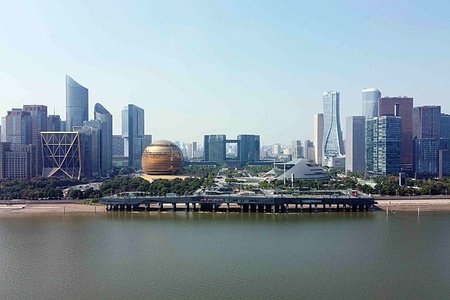
Note that in the citypopulation list, the neighbouring Shaoxing (绍兴 / 紹興, pop. 2,958,643) is counted as part of Hangzhou. It is famous for its Shaoxing wine, used for both drinking and cooking.

Ningbo
Name
Simplified Chinese: 宁波
Traditional Chinese: 寧波
Pronunciation
Mandarin pinyin: níng bō
Cantonese jyutping: ning4 bo1
Population
citypopulation.de: 7,100,000
census 2020 (metro): 7,335,604
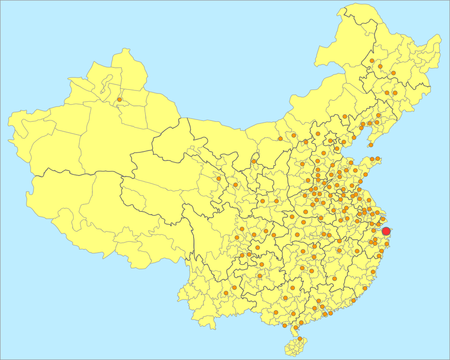
Ningbo is the second largest city in Zhejiang and one of the five "separate state-planning cities" (along with Dalian, Qingdao, Xiamen and Shenzhen), meaning it has autonomy over its economic and financial policies. The Ningbo-Zhoushan Port is the busiest container ports in the world by tonnage and the third busiest by number of containers.
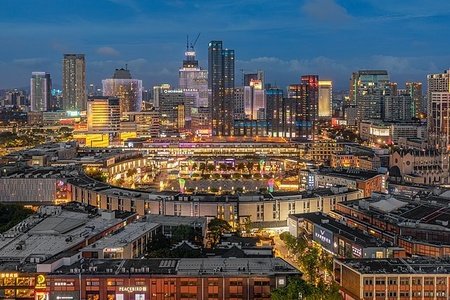
Yiwu
Name
Simplified Chinese: 义乌
Traditional Chinese: 義烏
Pronunciation
Mandarin pinyin: yì wū
Cantonese jyutping: ji6 wu1
Population
citypopulation.de: 2,475,000
census 2020 (metro): 1,859,390

Yiwu is a county-level city under Jinhua, and is a rare case in China that it is larger and more famous than its parent. It is best known as the world largest small-commodity market. It made the news when it managed to ship out replicas of Princess Catherine's engagement ring for $3 few days after the photo first appeared. It made headline again in 2016 when it correctly predicted Donald Trump's victory, as his merchandises outsold Hillary's one (yes all those MAGA stuffs are made in Yiwu). Finally, the nearby Hengdian World Studios is famous for having a real-size replica of the Forbidden City used for filming period dramas (see if you can spot it on Google Map satellite image).
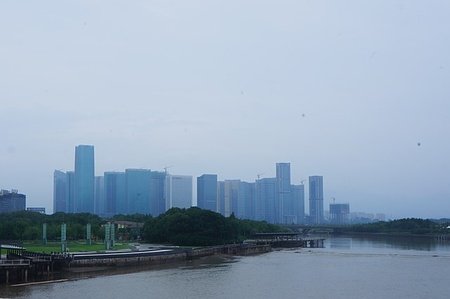
Jinhua
Name
Simplified Chinese: 金华
Traditional Chinese: 金華
Pronunciation
Mandarin pinyin: jīn huá
Cantonese jyutping: gam1 waa4
Population
citypopulation.de: 1,480,000
census 2020 (metro): 1,463,990
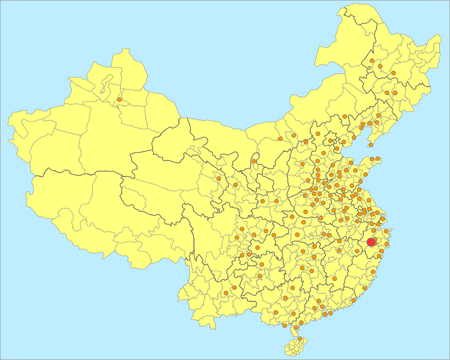
Yongkang
Name
Simplified Chinese: 永康
Traditional Chinese: 永康
Pronunciation
Mandarin pinyin: yŏng kāng
Cantonese jyutping: wing5 hong1
Population
citypopulation.de: 1,020,000
census 2020 (metro): 964,203
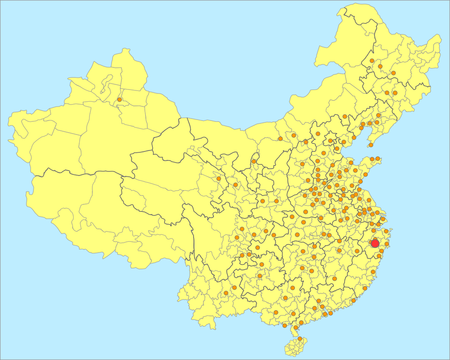
Yongkang is another county-level city under Jinhua. It is known as the "hardware capital of China" or "City of Metal" for its hardware production industry. Other than that, it is little known outside Zhejiang.
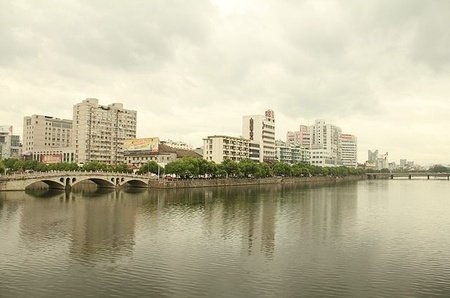
Shangrao
Name
Simplified Chinese: 上饶
Traditional Chinese: 上饒
Pronunciation
Mandarin pinyin: shàng ráo
Cantonese jyutping: soeng6 jiu4
Population
citypopulation.de: 1,410,000
census 2020 (metro): 1,293,399
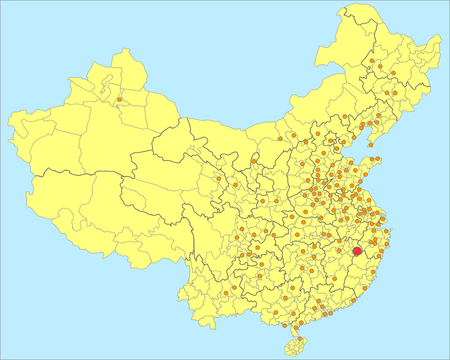
Taizhou
Name
Simplified Chinese: 台州
Traditional Chinese: 台州
Pronunciation
Mandarin pinyin: tái zhōu
Cantonese jyutping: toi4 zau1
Population
citypopulation.de: 2,525,000
census 2020 (metro): 2,162,461
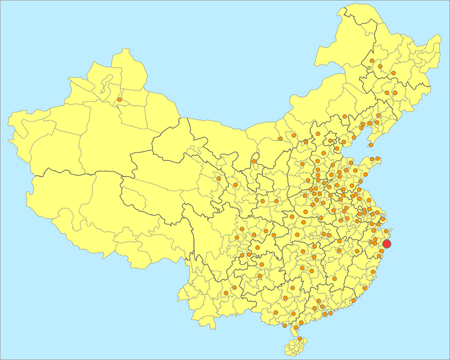
Taizhou is named after Tiantai Mountain, the origin of the Tiantai Buddhist school. Since the Reform and Opening-Up Policy in the 1980s, Taizhou entrepreneurs were the pioneers of private enterprises. The car manufacturer Geely (the owner of Volvo) was founded here.
One of our fellow JetPunkers came from this city, so ask him if you want to learn more.
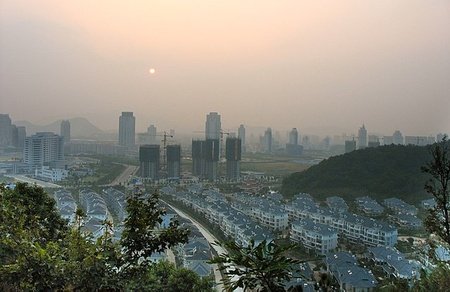
Wenzhou
Name
Simplified Chinese: 温州
Traditional Chinese: 溫州
Pronunciation
Mandarin pinyin: wēn zhōu
Cantonese jyutping: wan1 zau1
Population
citypopulation.de: 5,100,000
census 2020 (metro): 3,004,258
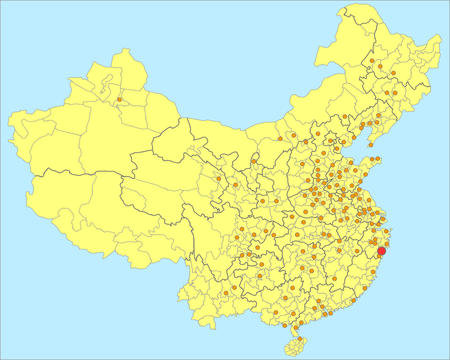
Wenzhou is surrounded by mountains and geographically isolated from the rest of China. As a result, the Wenzhou dialect is distinct and preserving many ancient Chinese terms. The city was designed in the 3rd century by the Father of Fengshui, thus considered having one of the best fengshui in China. Christianity is strong in Wenzhou, with many official and underground churches (and many with crucifixes forcefully removed by the government). Many of its entrepreneurs emigrated to Europe and the US. Nowadays, the Chinese diaspora in France, Italy and Spain mostly came from Wenzhou.

Cangnan
Name
Simplified Chinese: 苍南
Traditional Chinese: 蒼南
Pronunciation
Mandarin pinyin: cāng nán
Cantonese jyutping: cong1 naam4
Population
citypopulation.de: 1,710,000
census 2020 (metro): 1,308,654
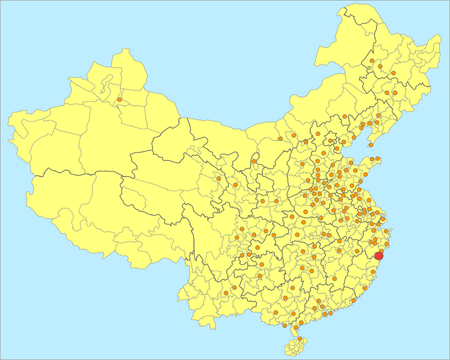
Fuzhou
Name
Simplified Chinese: 福州
Traditional Chinese: 福州
Pronunciation
Mandarin pinyin: fú zhōu
Cantonese jyutping: fuk1 zau1
Population
citypopulation.de: 4,550,000
census 2020 (metro): 4,094,491
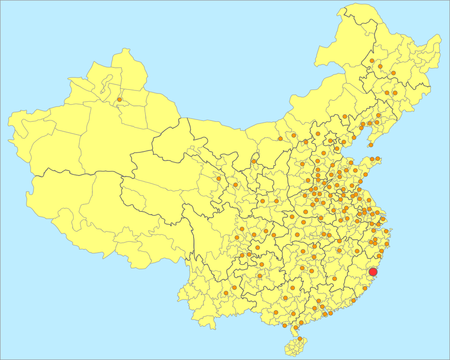
Fuzhou is the capital of Fujian (abbrev. Min). It is the home of the Eastern Min language. Similar to Wenzhou, it is the home of many overseas Chinese migrants, especially in Japan and the US.
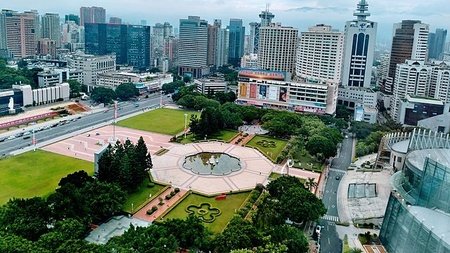
Xiamen
Name
Simplified Chinese: 厦门
Traditional Chinese: 廈門
Pronunciation
Mandarin pinyin: xià mén
Cantonese jyutping: haa6 mun4
Population
citypopulation.de: 14,500,000
census 2020 (metro): 5,163,970
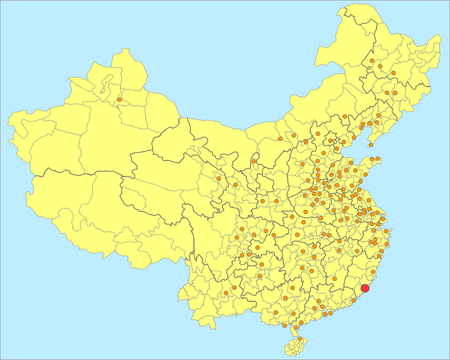
Xiamen, or Amoy, is located on the Xiamen Island. The Taiwanese controlled island of Kinmen is less than 6 km away. Another island Gulangyu used to be an international settlement (similar to Shanghai) and is now an UNESCO listed site attracting many tourists.
Home to Hokkien or the Southern Min language, it has a very close tie with Taiwan and attracted many Taiwanese investment.
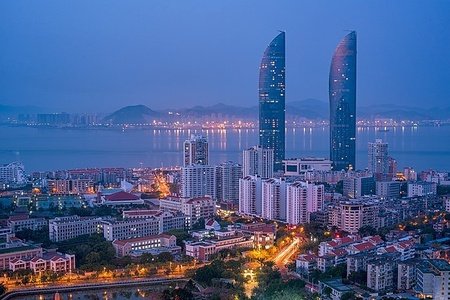
Note that the population figure quoted in citypopulation is hugely exaggerated, as it includes Quanzhou (泉州, pop. 1,374,090), Zhangzhou (漳州, pop. 2,120,178), Jinjiang (晋江 / 晉江, pop. 2,061,551), Shishi (石狮 / 石獅, pop. 685,930), and Putian (莆田, pop. 2,305,646), which is 140 km away from Xiamen.
Quanzhou in particular was an important port city historically. It was the starting point of the Maritime Silk Road. Marco Polo called it "one of the two greatest havens in the world for commerce" and the "Alexandria of the East".
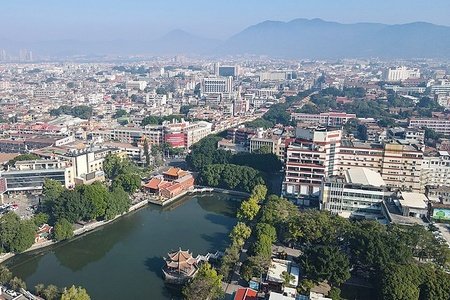
Sorry this is a long blog. I said I would go through 16 cities but ended up with 21 (blame it on citypopulation). In the next blog, I will move on to central south including cities in Hunan, Jiangxi, Guangdong and Hainan provinces.

